For the last three Thanksgivings, my wife Ruth and I have fled the metropolitan Atlanta area and sought “nature therapy” through the environments of Jekyll Island on the Georgia coast. For this all-too-short vacation, we take our bicycles with us, stay in a hotel near the beach, and ride for hours on Jekyll’s plentiful bike paths or long beaches, taking in the fresh sea air and stopping to look at and document any animal traces that catch our interest. It is ichnology with a low carbon footprint, natural history that’s also eco-chic. Best of all, though, we have been to Jekyll enough times to know where the best traces are likely to be found. Because of this inside knowledge and enthusiasm for all things ichnological, we sometimes discover phenomena, that, as far as we know, were previously unnoticed on any of the undeveloped Georgia barrier islands.
This Thanksgiving break was one of those times. The cast of characters in our latest novel find includes: two molluscans, knobbed whelks (Busycon carica) and dwarf surf clams (Mulinia lateralis); and two species of shorebirds, sanderlings (Calidris alba) and laughing gulls (Larus altricilla). How these four animals and their traces related to one another made for a fascinating story, nearly all of it discerned through their traces left on that Jekyll Island beach.
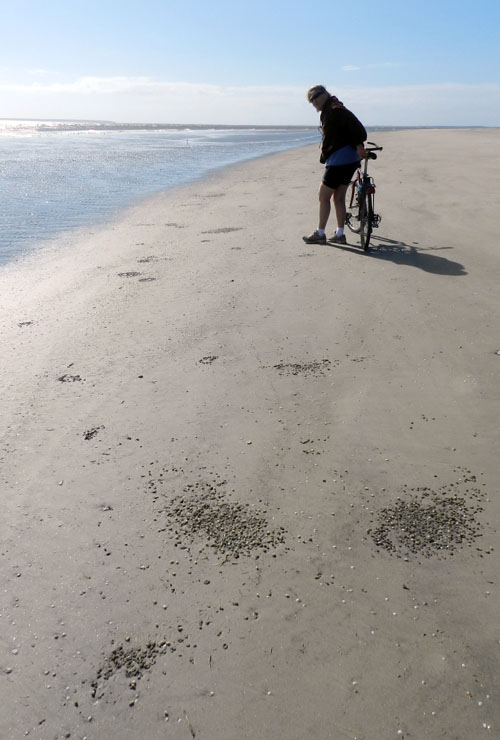 A view of a sandy beach on Jekyll Island at low tide with clusters of shallowly buried dwarf surf clams (Mulinia lateralis). These bivalves and their burrows, combined with beak marks and tracks of one of their predators, sanderlings (Calidris alba), make for the dark patches on the sand. But do you also see the abundant knobbed whelks (Busycon carica) and their traces in this photo? If not, please read on. (Ruth Schowalter for scale, happily standing by her bicycle, and photograph by Anthony Martin.)
A view of a sandy beach on Jekyll Island at low tide with clusters of shallowly buried dwarf surf clams (Mulinia lateralis). These bivalves and their burrows, combined with beak marks and tracks of one of their predators, sanderlings (Calidris alba), make for the dark patches on the sand. But do you also see the abundant knobbed whelks (Busycon carica) and their traces in this photo? If not, please read on. (Ruth Schowalter for scale, happily standing by her bicycle, and photograph by Anthony Martin.)
Jekyll is a developed island on the Georgia coast, its southern end about 30 kilometers (18 miles) north of the Georgia-Florida border, with sandy beaches, dunes, salt marshes, and maritime forests, all interrupted by residences, roads, golf courses, boutique shops, and other human-centered amenities. On the southeastern end of Jekyll, however, the beachside condominiums and hotels become fewer and the sandy natural areas correspondingly expand, holding bountiful traces of the local wildlife. With this geography in mind, we headed south on our bikes along the beach our first full day there. During this exhilarating outing, Ruth and I paused occasionally to figure out what animal activities might have taken place in the minutes or hours before our arrival, just after the high tide had turned and exposed broader areas of sandy beach.
We were not disappointed, as some traces immediately caught our attention. Low in the intertidal zone, we noticed upraised flaps of sand that marked the subsurface positions of variably sized knobbed whelks, which are among the largest marine snails in the eastern U.S. These whelks, brought in by the high tide and strong waves, had burrowed down into the sand as soon as the tide subsided. This behavioral mode has been positively reinforced by millions of years by natural selection, a tactic by the whelk that avoids both desiccation and predation.
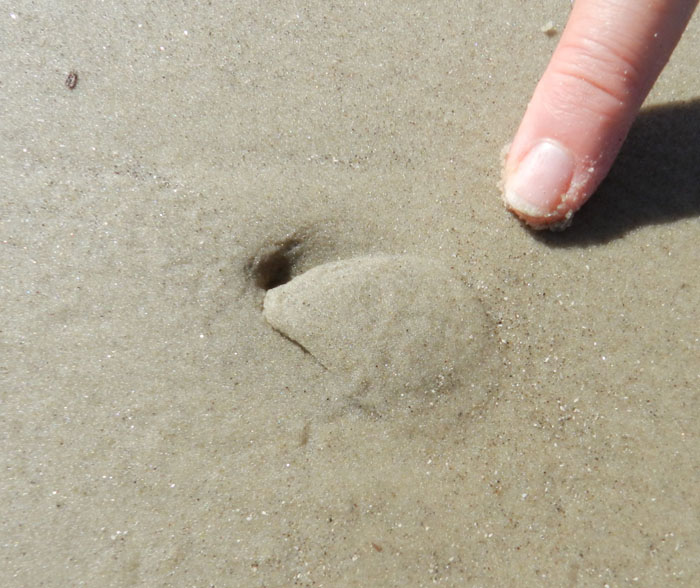
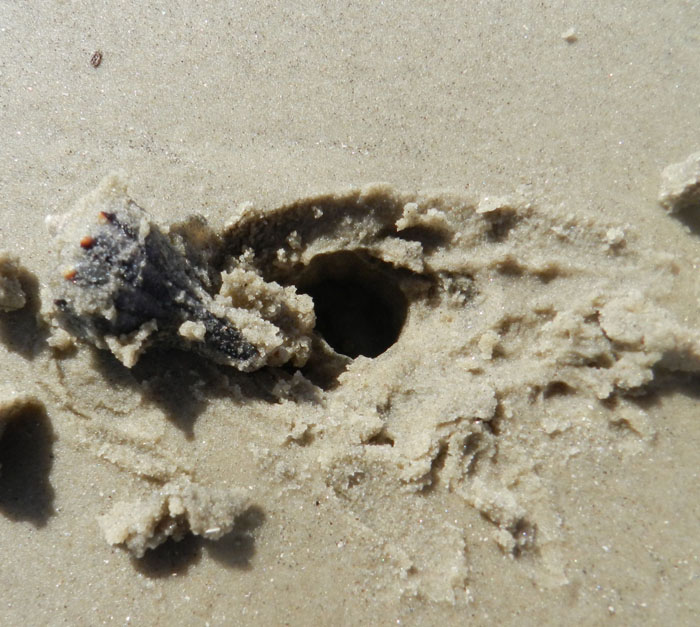 Here’s how to spot a buried whelk. Look for a triangular interruption in an otherwise smooth surface, where a flap of sand is slightly raised. Sometimes this trace also has a small hole at one end of the triangle. Test your hypothesis by digging in gently with your fingers. If you’re wrong, then revise your search image for their traces until you get it right. The knobbed whelk pictured here is a small one, but check out the size of the one in the next picture. (Both photographs by Anthony Martin, taken on Jekyll Island.)
Here’s how to spot a buried whelk. Look for a triangular interruption in an otherwise smooth surface, where a flap of sand is slightly raised. Sometimes this trace also has a small hole at one end of the triangle. Test your hypothesis by digging in gently with your fingers. If you’re wrong, then revise your search image for their traces until you get it right. The knobbed whelk pictured here is a small one, but check out the size of the one in the next picture. (Both photographs by Anthony Martin, taken on Jekyll Island.)
A whelk uses its muscular foot to bury itself, expanding and contracting it so that the foot probes into the still-saturated sand left by the high tide; once the foot anchors in the sand, it pulls the rest of the whelk sideways and down. This really isn’t so much “burrowing” as an intrusion, where the animal insinuates itself into the sand. Contrast this method with the active digging we normally associate with burrows made by most terrestrial animals with legs.
 A robust specimen of a knobbed whelk (held by Ruth), showing off its well-developed foot, which it uses to bury itself. (Photograph by Anthony Martin, taken on Jekyll Island.)
A robust specimen of a knobbed whelk (held by Ruth), showing off its well-developed foot, which it uses to bury itself. (Photograph by Anthony Martin, taken on Jekyll Island.)
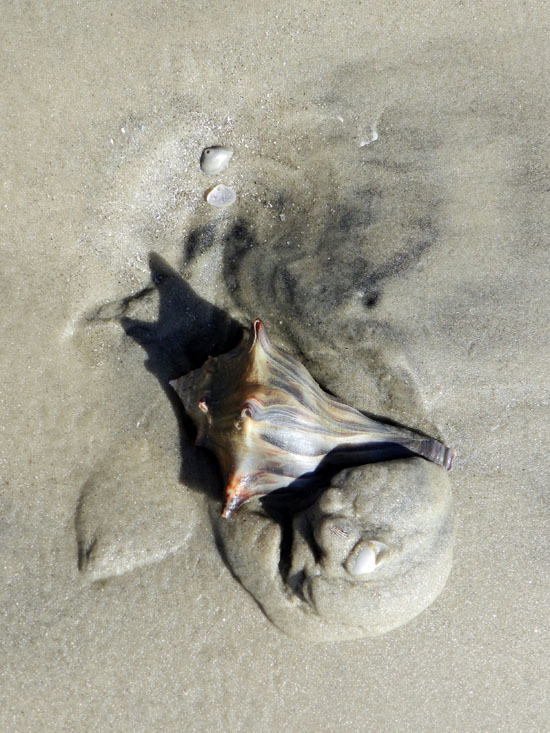 A knobbed whelk caught in the act of burying itself, leaving a short trail behind and a mound of sand in front as it starts to get underneath the beach surface. (Photograph by Anthony Martin, taken on Jekyll Island.)
A knobbed whelk caught in the act of burying itself, leaving a short trail behind and a mound of sand in front as it starts to get underneath the beach surface. (Photograph by Anthony Martin, taken on Jekyll Island.)
Once a whelk is buried, waves may wash over its trail, erasing all evidence of its preceding actions. Nonetheless, once emergent, seawater drains downward through the sand and tightens these grains around the whelk, denoting it as a triangular “trap door” that occasionally has a small hole at one end. This hole marks where the whelk expelled water through the bottom end of its shell.
Near these clear examples of whelk traces on this beach were clusters of dwarf surf clams. Similar to whelks, these clams were washed up by the hide tide and waves, and they instinctually burrowed once exposed on the surface. Although much smaller and more streamlined than knobbed whelks, they likewise use a muscular foot to intrude the sand, anchor, and pull in their shelled bodies. Under the right conditions, these clams will also leave a trail behind them before descending under the sand, although such traces are easily wiped clean by a single wave.
 Cluster of dwarf surf clams that burrowed into the sand at low tide, some noticeable through little “sand caps” on top of them. Say, I wonder why there’s a triangular-shaped bare spot of sand toward one end of that cluster? (Swiss Army knife = 6 cm (2.4 in) long; photograph by Anthony Martin, taken on Jekyll Island.)
Cluster of dwarf surf clams that burrowed into the sand at low tide, some noticeable through little “sand caps” on top of them. Say, I wonder why there’s a triangular-shaped bare spot of sand toward one end of that cluster? (Swiss Army knife = 6 cm (2.4 in) long; photograph by Anthony Martin, taken on Jekyll Island.)
Although dwarf surf clams ideally orient themselves vertically and push two siphons through the sand – making a Y-shaped burrow – they sometimes only have enough strength to bury themselves on their sides, hidden by a mere cap of sand. This bivalve equivalent of hiding under a blanket makes them much more vulnerable to predation, especially from shorebirds that find these clams and make quick snacks of them, such as sanderlings.
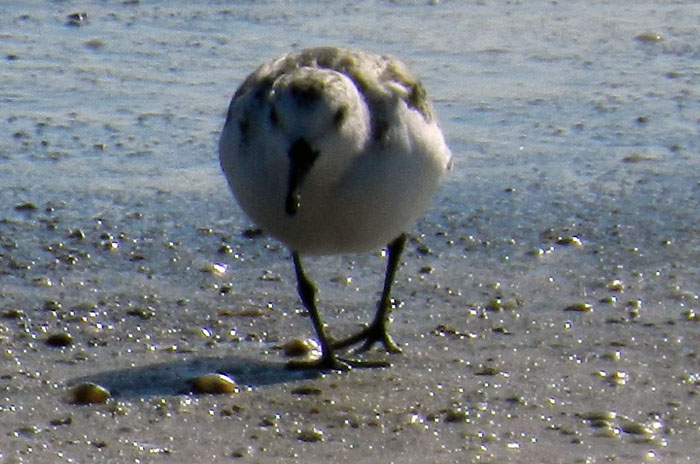 Sanderling (Calidris alba), 50-100 g of pure avian fury, prowling the sandy tidal flat of Jekyll Island in search of prey. Moon snails, given their fierce predation on other molluscans, may be the “lions of the tidal flat,” but as far as small crustaceans and clams are concerned, sanderlings are the “tyrannosaurs.” (Photograph by Anthony Martin, taken on Jekyll Island.)
Sanderling (Calidris alba), 50-100 g of pure avian fury, prowling the sandy tidal flat of Jekyll Island in search of prey. Moon snails, given their fierce predation on other molluscans, may be the “lions of the tidal flat,” but as far as small crustaceans and clams are concerned, sanderlings are the “tyrannosaurs.” (Photograph by Anthony Martin, taken on Jekyll Island.)
Sanderlings eat many small crustaceans that live in the sand, but they are also fond of small bivalves, such as dwarf surf clams. Sure enough, wherever you find a cluster of these clams, you will also find abundant tracks and beak probe marks made by these birds. Both their tracks and the probe patterns made by their beaks are diagnostic of this species: when I see these traces on any Georgia beach, I don’t have to look at a bird-identification guide to know whether sanderlings, dunlins, plovers, or sandpipers were there. Their food choices are clarified even more when you see their tracks and beak-probe marks directly associated with almond-shaped holes, where they neatly extracted the clams from their burrows.
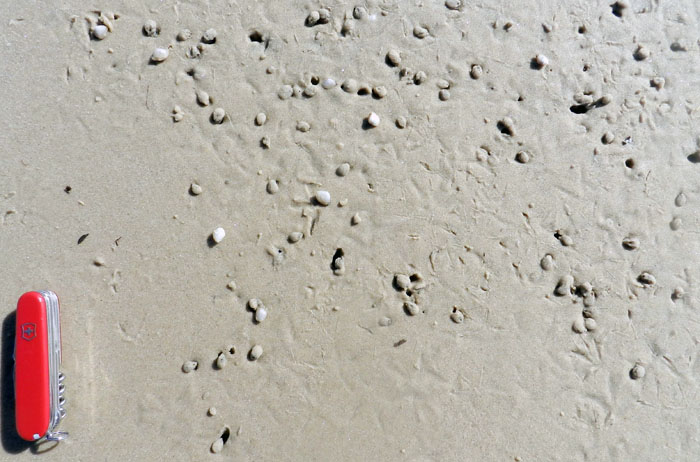 Sanderling tracks and beak-probe marks, with holes where clams were located by the sanderlings and plucked out of their shallow burrows. (Swiss Army knife = 6 cm (2.4 in) long; photograph by Anthony Martin, taken on Jekyll Island.)
Sanderling tracks and beak-probe marks, with holes where clams were located by the sanderlings and plucked out of their shallow burrows. (Swiss Army knife = 6 cm (2.4 in) long; photograph by Anthony Martin, taken on Jekyll Island.)
So how do these three species and their traces all relate to one another? (And what about the laughing gull?) Well, this is where it got even more interesting. Ruth and I soon started spotting triangular outlines within the clam clusters, bare spots on the sand devoid of both clams and beak marks. Underneath these were whelks. As we stood back and looked down the beach, we then saw how these clumps of clams were throughout the intertidal zone, and each was surrounding a whelk. Somehow the whelks had served as nucleation sites for clams, which had chosen to burrow in the sand around the whelks, instead of being randomly dispersed throughout the beach.
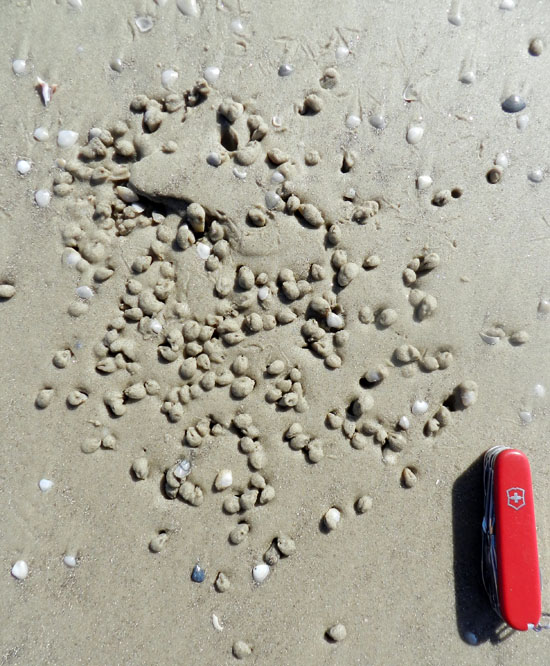 Remember this previous photo? There’s a whelk buried underneath that bare triangular patch.
Remember this previous photo? There’s a whelk buried underneath that bare triangular patch.
 Didn’t believe me? Well, there it is. It’s almost as if ichnology is a science, in which hypotheses, once confirmed by evidence-based reasoning, have predictive power.
Didn’t believe me? Well, there it is. It’s almost as if ichnology is a science, in which hypotheses, once confirmed by evidence-based reasoning, have predictive power.
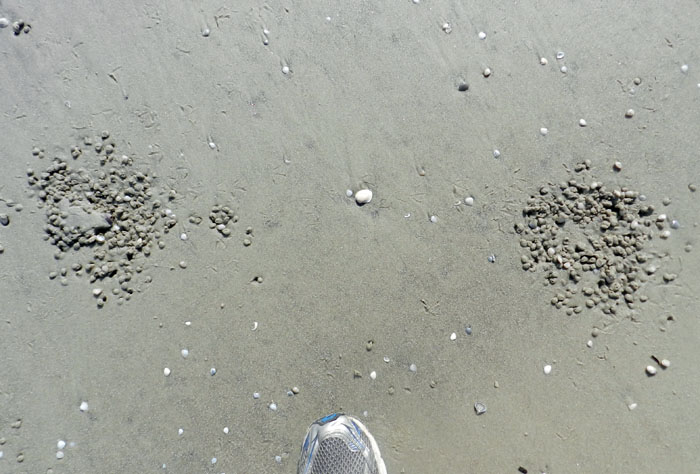 Here are two more clusters of dwarf surf clams around buried whelks, hidden but still identifiable.
Here are two more clusters of dwarf surf clams around buried whelks, hidden but still identifiable.
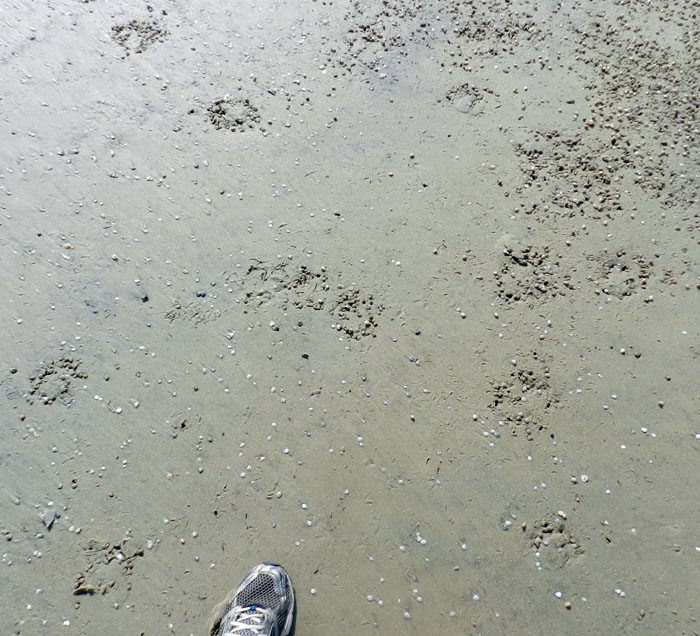 Quiz time: how many whelks are here? Thanks to ichnology, you don’t actually have to see them to dig them out for a census. (All four photographs by Anthony Martin and taken on Jekyll Island.)
Quiz time: how many whelks are here? Thanks to ichnology, you don’t actually have to see them to dig them out for a census. (All four photographs by Anthony Martin and taken on Jekyll Island.)
Why were the clams burrowing around the whelks? Was this some sort of commensalism, in which the clams found more food around the whelks? No, because these clams are filter feeders, taking in water with suspended organic material for their sustenance, instead of ingesting the sand around them. How about protection? That didn’t seem likely either, because the whelk had no interest in defending the clams, and its body wasn’t even serving as a shield against shorebirds.
So I thought about how these clams burrow, and then it all made sense. Because dwarf surf clams are so small, sand grains are more like cobbles would be to you and me. Moving through these sediments thus takes considerable effort, especially as water drains from the sand and surface tension holds together the grains more tightly. This means the clams have to take advantage of sand that acts more like quicksand and less like concrete, and burrow when the sand has lots of water between the grains.
This is where the whelk became both the unwitting friend and enemy of the dwarf surf clams. As it burrowed, it fluidized the sand around it, shaking up the grains so that more space opened between them, which allowed in more water. This zone of disturbance and liquified sand was eagerly exploited by nearby clams, which easily burrowed into both the whelks’ trails and the immediate areas around their bodies.
Alas, this opportunity for safety provided by the whelk ultimately led to the sanderlings chowing down on the clams. What might have been a meticulous search for small clams sprinkled hither and tither throughout the broad Jekyll beach had now became a lot easier, thanks to both the whelks and the clams. All a sanderling had to do was find each motherlode of clams conveniently grouped around a buried whelk and start probing. It was an all-you-can-eat clam feast, and the traces clearly showed where some of these birds stopped and took their time gorging on the clams. Their tracks also showed where one stopped sanderling attracted the attention of others, which then rushed to the scene and joined in the buffet.
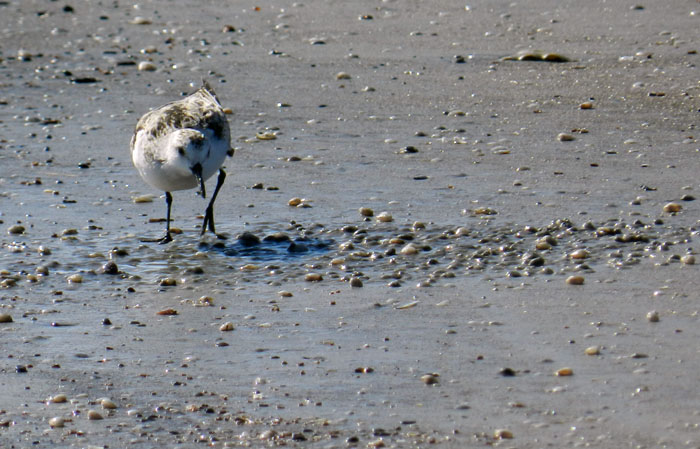 Wait, what have we here? A sanderling alters its course to investigate an obvious dense accumulation of dwarf surf clams. How did this population get so dense? Blame the knobbed whelk, which was just minding its own business by burrowing.
Wait, what have we here? A sanderling alters its course to investigate an obvious dense accumulation of dwarf surf clams. How did this population get so dense? Blame the knobbed whelk, which was just minding its own business by burrowing.
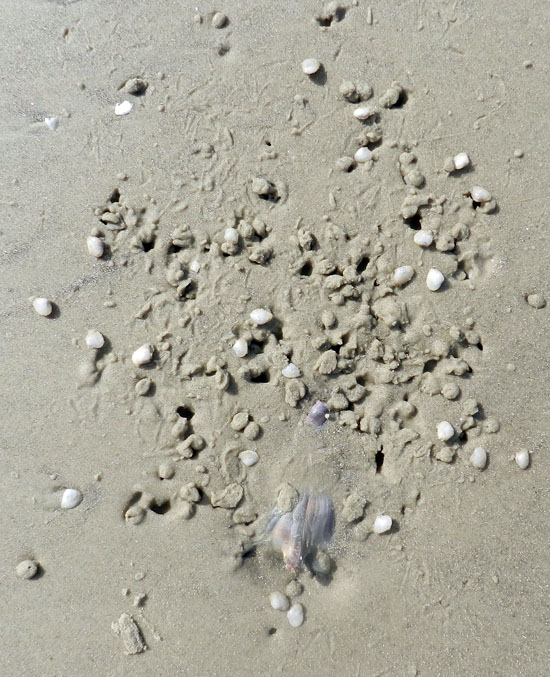 The carnage of sanderling plundering, in which about a third of buried dwarf surf clams were pulled from their burrows and the sand was trampled by thundering avian feet. This gruesome scene can all be laid at the feet, er, foot of the the whelk pictured here, which through its burrowing made it easier for the clams to burrow around it. (Both photographs by Anthony Martin and taken on Jekyll Island.)
The carnage of sanderling plundering, in which about a third of buried dwarf surf clams were pulled from their burrows and the sand was trampled by thundering avian feet. This gruesome scene can all be laid at the feet, er, foot of the the whelk pictured here, which through its burrowing made it easier for the clams to burrow around it. (Both photographs by Anthony Martin and taken on Jekyll Island.)
But what about the laughing gull and its role in this story? Sorry, that will have to wait until next week’s post. In the meantime, in these days immediately following the Thanksgiving holiday in the U.S., let us all be thankful for the natural areas still preserved on Jekyll Island that allow for such wanderings of our bodies and minds, as well as the little personal discoveries of its life traces, infused with wonder, that can be shared with others.
Further Reading
Elbroch, M., and Marks, E. 2001. Bird Tracks and Sign of North America. Stackpole Books. Mechanicsburg, Pennsylvania: 456 p.
Howard, J.D., and Dörjes, J., 1972. Animal-sediment relationships in two beach-related tidal flats: Sapelo Island, Georgia. Journal of Sedimentary Research, 42: 608-623.
MacLachlan, A., and Brown, A.C. 2006. The Ecology of Sandy Shorelines. Academic Press, New York: 373 p.
Powers, S.G., and Kittinger, J.N. 2002. Hydrodynamic mediation of predator–prey interactions: differential patterns of prey susceptibility and predator success explained by variation in water flow. Journal of Experimental Marine Biology and Ecology, 273: 171-187.
Wilson, J. 2011. Common Birds of Coastal Georgia. University of Georgia Press, Athens, Georgia: 219 p.

This is SO COOL! I’m sharing your stuff on my Facebook page, “Friends of Jekyll Island GA”. if there is a problem with that PLEASE let me know! In my enthusiasm I don’t look too closely at copyrights or the like! Thanks!
Lewis Baker
Jekyll Island Lover
I was on the island during the middle of November, the latest I had ever been during a year, and I noted lots of differences in life on the beach. Thank you for helping me better understand what I was seeing and why.